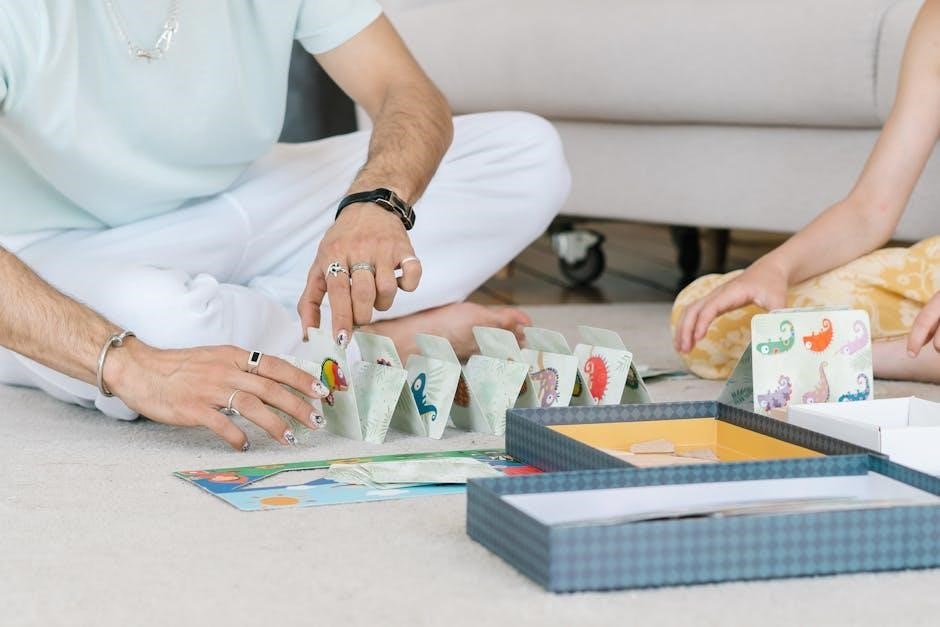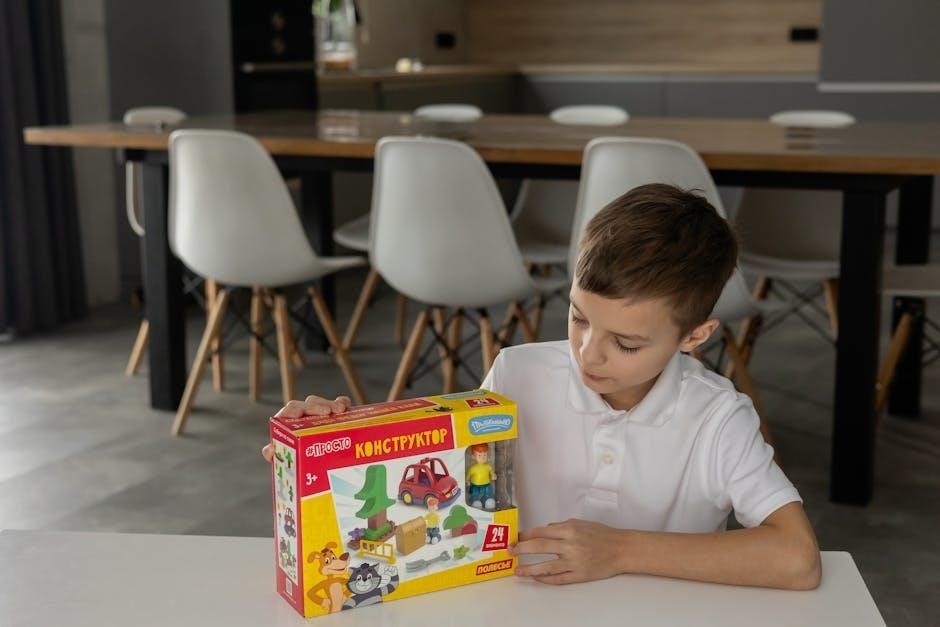Objective of the Game
The objective of Shut the Box is to close as many numbered tiles as possible by rolling dice․ Players aim to achieve the lowest score by flipping tiles that match the dice sum; Closing all tiles results in an instant win, known as “shutting the box․”
1․1 What is the goal of Shut the Box?
The primary goal of Shut the Box is to close as many numbered tiles as possible by rolling dice and matching the sum to the numbers on the tiles․ Players aim to flip down tiles corresponding to the dice totals, with the ultimate objective of closing all tiles to achieve an instant win, known as “shutting the box․” The game challenges players to strategically use their dice rolls to minimize the number of open tiles, as the player with the fewest remaining tiles at the end wins․ This simple yet strategic mechanic makes the game both engaging and rewarding․
1․2 How to achieve the lowest score
Achieving the lowest score in Shut the Box requires strategic planning and efficient use of dice rolls․ Players must aim to close the highest possible numbers first, as these contribute significantly to the total score․ By prioritizing larger numbers, players can minimize their final score․ Additionally, closing multiple numbers in a single turn can reduce the number of remaining tiles, further lowering the score․ The goal is to leave as few tiles open as possible, with the ideal outcome being zero open tiles, resulting in an instant victory․ This approach ensures a competitive edge and maximizes the chances of winning․

Setup and Basic Terminology
Shut the Box begins with all numbered tiles standing up․ Players take turns rolling two dice, using the sum to flip corresponding tiles․ The setup requires a game tray with numbered flaps and dice․ Understanding terms like “shutting the box” (closing all tiles) is essential for gameplay․ The objective is to minimize the score by closing tiles effectively, ensuring a smooth and competitive experience for all players involved in the game․ Proper setup and terminology knowledge are fundamental to enjoy the game fully․
2․1 Initial setup of the game
To begin, place all numbered tiles (1-9 or 1-12) in the upright position, ensuring they are fully visible․ Flip all number flaps up to prepare the game board․ Each player takes turns rolling two dice, starting with a random selection of the first player․ Place the dice in the designated area of the game tray․ Ensure all markers or tokens are off the board or set aside․ The game tray should be ready for flipping tiles based on dice rolls․ This setup ensures fairness and clarity for all players before the game starts․ Proper initialization is key to a smooth gameplay experience․
2․2 Key terms to understand
Numbered tiles: These are the flaps or panels labeled with numbers (1-9 or 1-12) that players aim to flip down․ Dice roll: The act of rolling two dice to determine which tiles can be lowered․ Flipping tiles: Closing tiles by flipping them down to match the dice sum․ Shutting the box: Closing all tiles, resulting in an instant win․ Game tray: The area where dice are rolled and tiles are flipped․ Score: The sum of remaining open tiles at the end of a turn or game․ Understanding these terms is essential for effective gameplay․
2․3 Preparing the game board
To prepare the game board, ensure all numbered tiles (1-9 or 1-12) are upright and visible․ Place any markers or tokens off the board or in designated areas․ Position the dice in the rolling area, typically a tray or open space․ Verify that all flaps or panels are fully open at the start․ The game board should be placed on a sturdy, flat surface to prevent movement during play․ Ensure all players agree on the initial setup before starting․ Proper preparation ensures smooth and fair gameplay for everyone involved․

How to Play the Game
Players roll dice, calculate the sum, and lower corresponding numbered tiles․ The turn continues until no valid moves remain, with the goal of closing as many tiles as possible․
3․1 Rolling the dice
Players begin their turn by rolling two dice into the game tray․ The dice are rolled onto the open area of the box, ensuring they land flat․ The sum of the dice determines which numbered tiles can be lowered․ For example, a roll of 5 allows the player to lower the number 5 tile or a combination of tiles that add up to 5․ Doubles (e․g․, two 3s) can be used to lower a single tile or two tiles of the same number․ The roll sets the stage for the rest of the turn, guiding which tiles can be closed․
3․2 Calculating the sum of the dice
After rolling the dice, the next step is to calculate their total sum․ The sum determines which numbered tiles can be lowered․ For example, if the dice show a 3 and a 4, the total is 7․ The player can then lower the number 7 tile or any combination of tiles that add up to 7, such as 3 and 4․ Doubles (e․g․, two 5s) allow the player to lower the number 5 tile or two tiles of 5․ The sum guides the player’s strategy for closing tiles efficiently during their turn․
3․3 Lowering the numbered tiles
After calculating the dice sum, players lower the corresponding numbered tiles on the game board․ For example, a sum of 5 allows lowering the number 5 tile or any combination of tiles that add up to 5 (e․g․, 2 and 3)․ Doubles (e․g․, two 3s) permit lowering the number 3 tile or two tiles of 3․ Players can lower multiple tiles in one turn if the sum matches their combinations․ Tiles cannot be reopened once lowered, so strategy is key to maximize closures and minimize the final score․
3․4 Continuing the turn
A player continues their turn by rolling the dice again after lowering tiles․ The process repeats, with the goal of closing more tiles each time․ If the dice sum matches remaining tiles, the player must lower them․ The turn ends when no valid moves are left, and the player scores based on uncovered tiles․ If all tiles are closed, the player instantly wins by “shutting the box․” strategist players aim to extend their turns to minimize their final score, maximizing their chances of victory․

Scoring and Winning
Scoring is based on the sum of uncovered tiles․ The player with the lowest score wins․ Closing all tiles results in an instant win, known as “shutting the box․”
4․1 How to calculate the score
The score is determined by summing the numbers on all uncovered tiles at the end of the game․ Players flip tiles corresponding to their dice rolls, with each tile only being flipped once․ For example, if three tiles remain open, the score is the sum of those three numbers․ The player with the lowest total score wins․ If all tiles are closed, the player achieves a perfect score and wins instantly․ The scoring system encourages strategic tile selection to minimize the final sum of uncovered numbers․
4․2 Conditions for winning the game
A player wins by achieving the lowest score, calculated by summing uncovered tiles․ If all tiles are closed, the player wins immediately․ The game concludes when one player successfully shuts the box or all players have taken their turns․ The winner is the player with the fewest points, emphasizing strategic dice rolls and tile selection․ Proper adherence to rules ensures fair competition and determines the victor based on skillful play and luck․
4․3 Instant win by shutting the box
Shutting the box occurs when a player successfully closes all numbered tiles․ This results in an immediate victory, regardless of other players’ scores․ Achieving this requires strategic dice rolls and efficient tile management․ Players must precisely match dice sums to remaining tiles to close them all․ If accomplished, the game ends instantly, and the player is declared the winner․ This ultimate goal showcases mastery of the game and is the most prestigious way to win, highlighting skill and luck․

Game Variations and Rules
Shut the Box offers variations like team play and special rules, enhancing strategy and fun․ Different versions cater to diverse player preferences and skill levels․
5․1 Different versions of the game
Shut the Box has several variations, including classic, team, and dice-specific versions․ The classic version uses two dice, while others may use three or jumbo dice for added challenge․ Team play allows multiple players to collaborate, sharing strategies to lower scores․ Some versions include special rules, such as doubling the score for certain rolls or requiring specific combinations to close tiles․ These variations add diversity to the game, making it adaptable to different player preferences and skill levels while maintaining its core objective of closing numbered tiles efficiently․
5․2 Rules for team play
In team play, players divide into groups, sharing the goal of closing tiles collectively․ Teams take turns rolling dice, with each member contributing to lowering tiles․ Communication is key, as strategies must be coordinated to minimize the final score․ If one team member shuts the box, the team wins instantly․ Scores are combined at the end, and the team with the lowest total wins․ This collaborative approach fosters camaraderie and shared problem-solving, adding a social dynamic to the traditional solo gameplay while maintaining the excitement of the original game․
5․3 Special rules and exceptions
Special rules in Shut the Box include handling doubles, where rolling identical numbers allows strategic choices․ Some versions permit “doubling up,” forcing opponents to match the roll․ The “kitty” rule involves an ante from all players, adding stakes to the game․ Certain editions allow players to remove a tile permanently once closed, preventing others from reopening it․ Additionally, some games feature penalties for failing to close tiles, increasing the challenge․ These exceptions enhance gameplay depth and variability, offering unique twists for experienced players seeking greater complexity and excitement in their matches․ These rules can significantly alter the game’s dynamics;

Strategies for Success
Plan ahead to minimize leftover numbers․ Focus on closing higher-value tiles early to reduce potential points․ Use dice rolls strategically to target remaining numbers effectively․
6․1 Effective strategies to win
To win at Shut the Box, focus on minimizing the number of uncovered tiles․ Prioritize closing higher-value tiles first, as they contribute more to the final score․ Plan ahead by targeting combinations of numbers that add up to the dice total․ Avoid leaving single tiles uncovered, as they increase your score․ Use each dice roll strategically to cover the most beneficial numbers․ Stay focused on the remaining tiles and adapt your strategy as the game progresses․ A well-thought-out approach ensures you close more tiles and achieve a lower score, increasing your chances of victory․
6․2 Common mistakes to avoid
Common mistakes in Shut the Box include prioritizing lower-numbered tiles over higher ones, which can leave you with a higher final score․ Players often overlook planning ahead, failing to consider which tiles to close for future rolls․ Another mistake is ignoring the sum of remaining tiles, which can lead to unnecessary points․ Avoid rushing decisions and not adapting to the game’s progression․ These errors can significantly increase your score and reduce your chances of winning․ Stay focused, plan strategically, and avoid these pitfalls to improve your gameplay and achieve a lower score․
6․3 Advanced techniques for experienced players
Experienced players can enhance their gameplay by mastering strategic tile management․ Focus on closing higher-value tiles early to minimize potential points․ Use dice combinations creatively to target specific numbers․ Optimize your rolls by calculating the best tiles to close based on remaining options․ Advanced players also anticipate future moves, ensuring flexibility for subsequent rolls․ Avoid leaving tiles that cannot be paired later․ By strategically planning and adapting, experienced players can significantly reduce their final score and increase their chances of shutting the box or achieving a low score․ These techniques require foresight and precise execution․

Etiquette and Gameplay Rules
Respect turns, handle dice carefully, and avoid interrupting others․ Ensure all moves are valid and tiles are correctly lowered․ Maintain a clean play area always․
7․1 Proper conduct during the game
7․1 Proper Conduct During the Game
Players should maintain respectful behavior, allowing others to focus on their turns․ Avoid distractions and ensure all actions are clear and audible․ Proper conduct includes waiting for your turn, handling dice gently, and keeping the game area tidy․ Any disputes should be resolved amicably, with agreement on rules beforehand to ensure smooth gameplay․ Courtesy and patience among players enhance the overall enjoyment of the game, fostering a positive and fair environment for everyone involved․ Adhering to these guidelines ensures a pleasant experience for all participants․
7․2 Handling doubles and special rolls

7․2 Handling Doubles and Special Rolls
When rolling doubles (both dice showing the same number), players can lower two tiles of that number or one tile of double the value․ For example, rolling two 3s allows lowering two 3s or one 6․ If a player cannot lower the required tiles, their turn ends․ Special rolls, such as doubles, often grant an extra roll or additional scoring opportunities․ Players must clearly announce their actions to ensure transparency․ Proper handling of doubles and special rolls ensures fair play and maintains the flow of the game, adhering to established rules and promoting a smooth experience for all participants․
7․3 Managing the game tiles
7․3 Managing the Game Tiles
Properly managing the game tiles is essential for smooth gameplay․ Players must ensure all tiles are upright at the start of each turn․ Once a tile is lowered, it cannot be raised again․ If a tile is accidentally lowered incorrectly, it should be restored to its original position․ Players should handle tiles gently to avoid damaging the game board․ Organizing the tiles neatly helps maintain clarity and fairness․ Each player is responsible for managing their own set of tiles, ensuring they are correctly positioned and visible to all participants․ Proper tile management enhances the overall gaming experience and ensures accurate scoring․

History of the Game
Shut the Box originated in 19th-century Europe, becoming a popular pub and family game․ Its design evolved over time, remaining a beloved classic across generations․
8․1 Origins of Shut the Box
Shut the Box traces its origins to 19th-century Europe, where it emerged as a popular pub game․ Initially crafted from wood, the game involved closing numbered flaps based on dice rolls․ Its simplicity and strategic depth made it a favorite among both casual players and competitive enthusiasts․ Over time, the game spread globally, adapting to various cultures while retaining its core mechanics․ Historians believe it was influenced by earlier dice games, evolving into the beloved classic we know today, with its enduring appeal spanning generations and continents alike․
8․2 Evolution over time
Shut the Box has evolved significantly since its inception․ Early versions used basic materials like wood, while modern sets often feature durable plastics and electronic components․ The game has also seen variations in the number of tiles, with some versions using 9 tiles and others 12․ Over time, rules have adapted to include team play and special conditions, adding depth to the gameplay․ Despite these changes, the core objective of closing tiles to achieve the lowest score has remained consistent, ensuring its enduring appeal and versatility for players of all ages and skill levels․
8․3 Cultural significance
Shut the Box holds a special place in gaming culture, often associated with pubs and social gatherings․ Its simplicity and strategic depth make it accessible to a wide audience, fostering camaraderie and competition․ The game has become a staple in many cultures, symbolizing both entertainment and intellectual challenge․ Its enduring popularity highlights its ability to transcend generations, serving as a timeless activity that bridges gaps between players of all backgrounds and ages․ The game’s adaptability to various settings has cemented its cultural relevance, ensuring its continued enjoyment for years to come․
Benefits of Playing
Shut the Box enhances cognitive skills, promotes social interaction, and provides entertainment․ It improves mental arithmetic, strategic thinking, and fosters friendly competition among players of all ages․
9․1 Cognitive benefits
Playing Shut the Box enhances mental sharpness by improving arithmetic skills, memory, and strategic thinking․ The constant need to calculate dice sums and decide which tiles to lower sharpens focus and problem-solving abilities․ Players develop quick decision-making and adaptability as they aim to close the highest possible numbers․ The game also boosts patience and concentration, as players must carefully plan their moves to achieve the lowest score․ Regular play can improve cognitive agility and mathematical accuracy, making it an engaging and intellectually stimulating activity for all ages․
9․2 Social interaction
Shut the Box fosters social interaction by encouraging players to engage with one another during gameplay․ The competitive yet friendly nature of the game allows for lively banter and shared excitement․ Players often discuss strategies or celebrate successful moves, creating a sense of camaraderie․ In team play, collaboration and communication are key, further enhancing social bonding․ The game’s simplicity makes it accessible to diverse groups, making it a popular activity in casual gatherings or pubs․ This interaction not only entertains but also strengthens relationships through shared experiences and mutual enjoyment․
9․3 Entertainment value
‘ on the topic ‘instructions for shut the box game’․ The user has given me some specific instructions, so let me make sure I understand them correctly․
First, they want me to always use exactly , no more, no less․ That’s crucial because they emphasized it multiple times․ I need to be careful with the word count to meet this requirement precisely․
Looking at the user’s previous interactions, they provided some information from the internet about the game․ I should use that as a basis but focus on the entertainment aspect now․ The game seems to be a classic pub game that involves rolling dice and flipping tiles, which sounds inherently entertaining․ I should highlight the elements that make it fun and engaging․
The user also mentioned that I should avoid any overlap with other subheadings․ Since this is about entertainment value, I need to focus on aspects like fun, engagement, excitement, and social enjoyment without veering into strategies, rules, or other categories․
To start, I’ll brainstorm what makes Shut the Box entertaining․ It involves rolling dice, which introduces an element of chance and unpredictability, making each turn exciting․ The goal of closing numbered tiles provides a clear objective, which can be satisfying to achieve․ The game seems simple enough for anyone to pick up, making it accessible and inclusive for different types of players․
Moreover, the competitive nature of trying to get the lowest score or shutting the box entirely can create a sense of rivalry and excitement among players․ The instant win by shutting the box adds a thrilling moment that can elevate the entertainment factor․
Considering social interaction, which was covered in the previous subheading, I need to avoid overlapping․ Instead, I’ll focus on how the game’s mechanics and objectives contribute to its entertainment value․ Maybe mention the fast-paced nature of the game and how it keeps players engaged and eager for their next turn․
I should also think about the emotional highs, like the excitement of successfully closing multiple tiles or the suspense of not knowing the dice outcome․ These elements keep the game dynamic and fun․
Now, structuring this into a coherent paragraph with exactly ․ I’ll need to be concise but comprehensive․ Starting with an overview of the game’s entertainment aspects, then delving into specific features like dice rolling, tile closing, and the competitive elements․
Let me draft a version:
”
Shut the Box offers immense entertainment through its engaging gameplay and unpredictability․ Players enjoy the thrill of rolling dice and strategically closing numbered tiles, creating a dynamic experience․ The simplicity of the game makes it accessible to all, fostering a fun environment․ The competitive aspect of achieving the lowest score or an instant win by shutting the box adds excitement․ Each turn brings suspense and satisfaction, making the game a delightful activity for social gatherings, ensuring hours of enjoyment and laughter among players of all ages․
”
Now, let me check the word count․ “Shut the Box offers immense entertainment through its engaging gameplay and unpredictability․ Players enjoy the thrill of rolling dice and strategically closing numbered tiles, creating a dynamic experience․ The simplicity of the game makes it accessible to all, fostering a fun environment․ The competitive aspect of achieving the lowest score or an instant win by shutting the box adds excitement․ Each turn brings suspense and satisfaction, making the game a delightful activity for social gatherings, ensuring hours of enjoyment and laughter among players of all ages․”
Counting the words:
Shut
the
Box
offers
immense
entertainment
through
its
engaging
gameplay
and
unpredictability․
Players
enjoy
the
thrill
of
rolling
dice
and
strategically
closing
numbered
tiles,
creating
a
dynamic
experience․
The
simplicity
of
the
game
makes
it
accessible
to
all,
fostering
a
fun
environment․
The
competitive
aspect
of
achieving
the
lowest
score
or
an
instant
win
by
shutting
the
box
adds
excitement․
Each
turn
brings

suspense
and
satisfaction,
making
the
game
a
delightful
activity
for
social
gatherings,
ensuring
hours
of
enjoyment
and
laughter
among
players
of
all
ages․
That’s , which is under the required 93․ I need to add more without repeating anything․ Maybe add a bit more about the social aspect without overlapping with subheading 9․2․
Revised version:
”
Shut the Box offers immense entertainment through its engaging gameplay and unpredictability․ Players enjoy the thrill of rolling dice and strategically closing numbered tiles, creating a dynamic experience․ The simplicity of the game makes it accessible to all, fostering a fun environment․ The competitive aspect of achieving the lowest score or an instant win by shutting the box adds excitement․ Each turn brings suspense and satisfaction, making the game a delightful activity for social gatherings․ Its fast-paced nature ensures continuous engagement, providing hours of enjoyment and laughter among players of all ages, making it a timeless favorite for casual and competitive fun alike․
”
Now, counting the words:
Shut
the
Box
offers
immense
entertainment
through
its
engaging
gameplay
and
unpredictability․
Players
enjoy
the
thrill
of
rolling
dice
and
strategically
closing
numbered
tiles,
creating
a
dynamic
experience․
The
simplicity
of
the
game
makes
it
accessible
to
all,
fostering
a
fun
environment․
The
competitive
aspect
of
achieving
the
lowest
score
or
an
instant
win
by
shutting
the
box
adds
excitement․
Each
turn
brings
suspense
and
satisfaction,
making
the
game
a
delightful
activity
for
social
gatherings․
Its
fast-paced
nature
ensures
continuous
engagement,
providing
hours
of
enjoyment
and
laughter
among
players
of
all
ages,
making
it
a
timeless
favorite
for
casual
100․ and
101․ competitive
102․ fun
103․ alike․
Oops, that’s over ․ I need to trim it down to exactly 93․ Let me adjust the last sentence․
Revised:
”
Shut the Box offers immense entertainment through its engaging gameplay and unpredictability․ Players enjoy the thrill of rolling dice and strategically closing numbered tiles, creating a dynamic experience․ The simplicity of the game makes it accessible to all, fostering a fun environment․ The competitive aspect of achieving the lowest score or an instant win by shutting the box adds excitement․ Each turn brings suspense and satisfaction, making the game a delightful activity for social gatherings․ Its fast-paced nature ensures continuous engagement, providing hours of enjoyment and laughter for players of all ages, making it a timeless favorite for casual and competitive fun․
”
Now, word count:
Shut
the
Box
offers
immense
entertainment
through
its
engaging
gameplay
and
unpredictability․
Players
enjoy
the
thrill
of
rolling
dice
and
strategically
closing
numbered
tiles,
creating
a
dynamic
experience․
The
simplicity
of
32
Shut the Box combines luck and strategy, offering fun for all ages․ Mastering the game brings satisfaction, making it a timeless, enjoyable challenge for everyone․
10․1 Final tips for mastery
To master Shut the Box, plan your moves carefully and focus on closing lower numbers first to minimize your final score․ Practice regularly to improve your strategic thinking and dice roll accuracy․ Stay calm and patient during gameplay, as rushing can lead to missed opportunities․ Always consider the risks of rolling doubles, as they can limit your options․ By combining skill and luck, you can consistently achieve lower scores and outperform your opponents․ Keep experimenting with different strategies to refine your approach and enjoy the challenge of this engaging game․
10․2 Encouragement to play
Shut the Box is a fun and challenging game that offers endless entertainment while sharpening your math skills and strategic thinking․ Whether you’re playing solo or with friends, it’s a great way to enjoy social interaction and healthy competition․ The game’s simplicity makes it accessible to all ages, while its depth ensures it remains engaging for experienced players․ Don’t hesitate to give it a try—its unique blend of luck and strategy makes it a rewarding experience for everyone․ Embrace the challenge and enjoy the thrill of trying to shut the box!